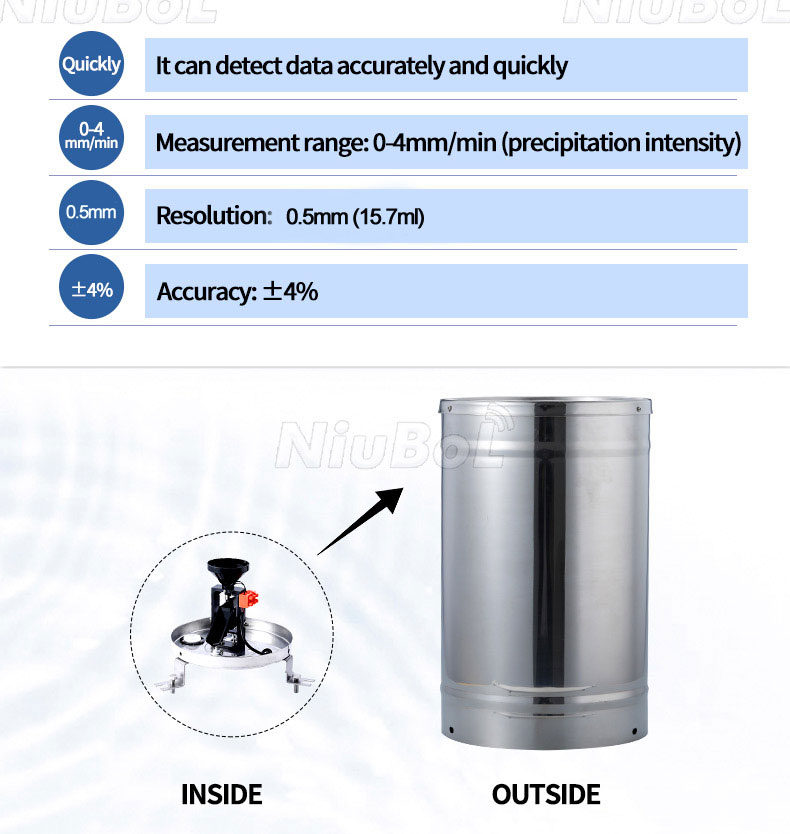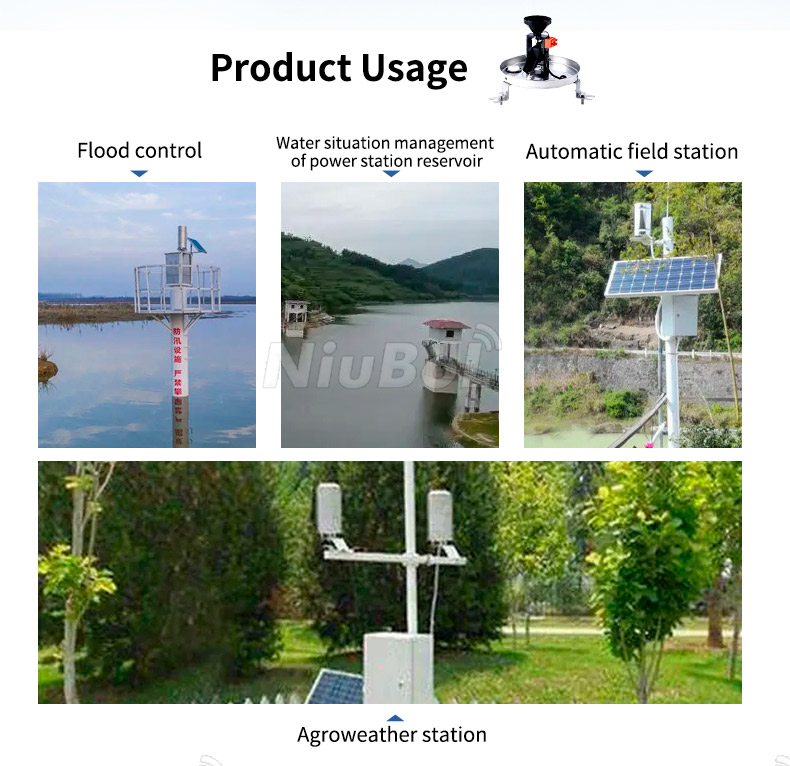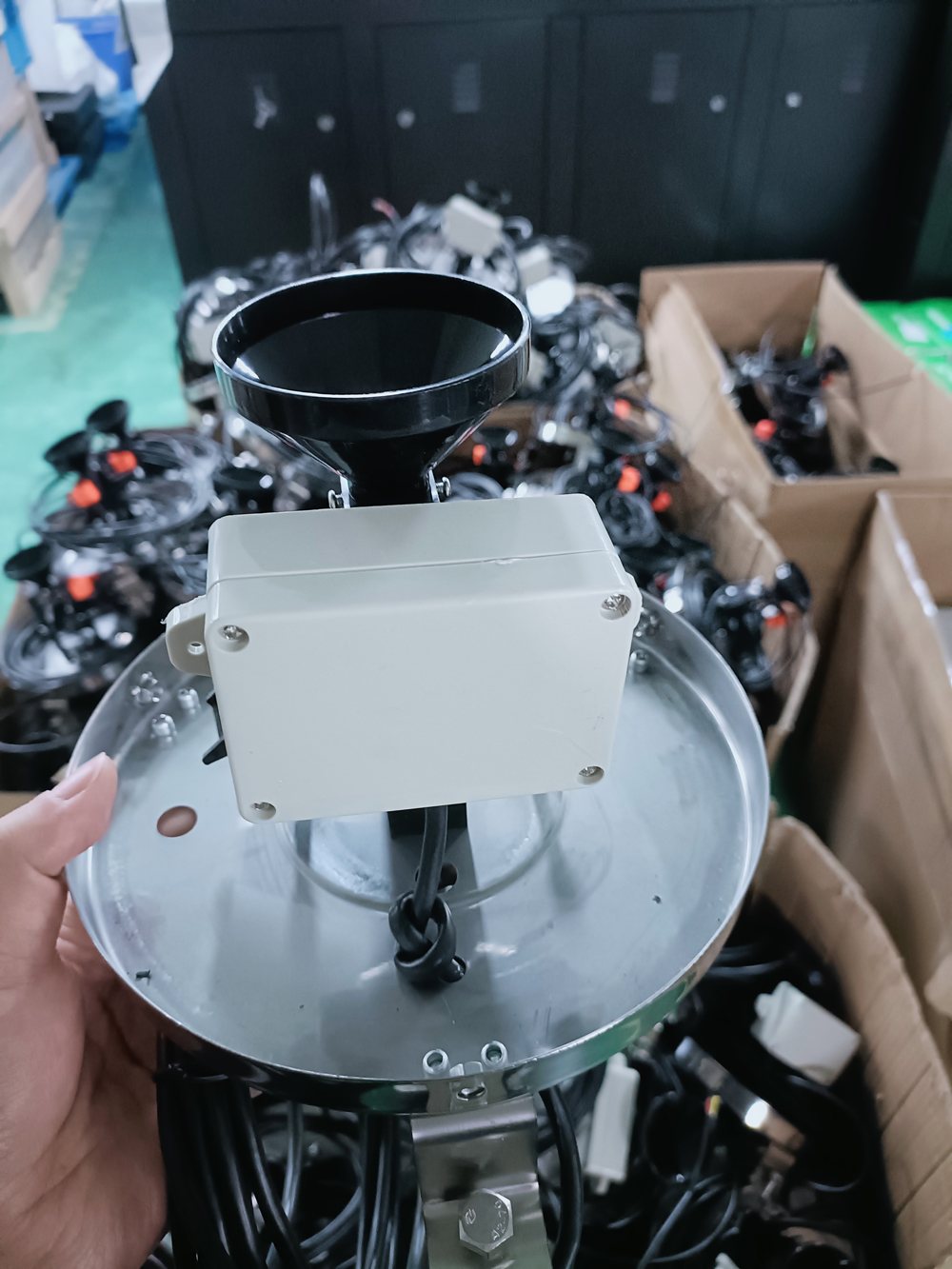

— Blogs —
—Products—
 Consumer hotline +8618073152920
Consumer hotline +8618073152920 WhatsApp:+8615367865107
Address:Room 102, District D, Houhu Industrial Park, Yuelu District, Changsha City, Hunan Province, China
Product knowledge
Time:2024-08-14 17:16:12 Popularity:1672
A precipitation sensor, also known as a rain sensor or rain gauge sensor, is a hydrometeorological instrument used to measure the amount of rainfall in nature. It is capable of converting the amount of rainfall collected into a digital signal for easy data transmission, processing, recording and display. These sensors are vital for meteorological research, water resource management, agricultural planning, flood warning, and environmental monitoring.
There are several types of precipitation sensors on the market, each with different operating principles and application characteristics. The following are some of the common types of precipitation sensors:
1. Rain gauge (Pluviometer):
- Type: usually refers to various types of rain sensors.
- Characteristics: Simple structure, works by collecting and measuring the total amount of precipitation.
2. Optical Rain Sensor:
- Principle of operation: detects precipitation using a light beam. When a raindrop passes through the light beam, it changes the intensity or path of the light, thus detecting rainfall.
- Characteristics: It can detect the size and speed of raindrops, and is suitable for occasions where high-precision measurements are required.
3. Weighing type rain sensor:
- Principle of operation: Measures the weight of collected precipitation by weighing.
- Characteristics: able to provide very accurate precipitation data, suitable for scientific research and high-precision monitoring.
The bucket rain sensor is an important type of precipitation sensor, which converts rainfall into quantifiable digital information through a specific mechanical structure. The sensor mainly consists of rain bearer, tipping bucket, reed switch and other components, and its working principle is roughly as follows:
Rainwater is first collected through the rainmaker and flows into the tipping bucket through the filter funnel.
When the amount of water inside the tipping bucket reaches a certain height (e.g. 0.1mm, 0.2mm or 0.5mm), the tipping bucket will lose its balance and turn over, discharging the water.
Each flip of the tipping bucket generates a pulse signal through the reed switch, which is subsequently transmitted to the data acquisition system.
The data acquisition system calculates the actual rainfall based on the number of pulse signals received.
Each type of precipitation sensor has its own specific application scenarios and advantages. The choice of which type of sensor to use usually depends on factors such as the required measurement accuracy, environmental conditions, cost, and maintenance requirements.
The tipping bucket rain sensor has the following significant functional characteristics:
1. High-precision Measurement: Due to the use of precise mechanical structure and electronic components, the tipping bucket rain sensor is able to realise high-precision measurement of rainfall. Its resolution can reach 0.1mm or 0.2mm, which meets the needs of different application scenarios.
2. High degree of automation: the sensor can automatically complete the process of precipitation collection, measurement and data transmission, without human intervention, greatly improving the efficiency and accuracy.
3. Easy to install and maintain: the installation process of the tipping bucket rain sensor is relatively simple, just follow the instructions. At the same time, its maintenance costs are low, suitable for long-term use in the field environment.
4. Convenient data transmission: the sensor supports a variety of data acquisition systems supporting the use of wired or wireless data transmission, convenient for users to obtain precipitation data at any time.
5. Adaptable: with outdoor all-environmental design, can resist bad weather, and has a heating function to adapt to the low-temperature environment.
6. Low power consumption and durability: suitable for long-term unattended field work environment, low maintenance requirements.
7. Easy to digitise: the output digital signal is easy to combine with modern information technology, suitable for automatic weather stations and hydrological automatic measurement and reporting systems.

Rainfall sensors are widely used in the following scenarios due to their unique functional characteristics:
1. Meteorological observation stations: In meteorological observation stations, precipitation sensors are used to monitor and record precipitation data in real time, providing an important basis for weather forecasting and climate research.
2. Hydrological monitoring stations: In hydrological monitoring stations, the sensor is used to monitor the precipitation situation of rivers, lakes and other water bodies, providing decision support for flood prevention, drought relief and water resource management.
3. Agricultural field: In agricultural production, the precipitation sensor can be used to monitor the precipitation of farmland, helping farmers to rationally arrange irrigation and drainage work, and improve the yield and quality of crops.

4. Environmental protection: in the field of environmental protection, the sensor can be used to monitor the impact of rainfall on soil erosion, water pollution and other environmental issues, to provide data support for environmental decision-making.
5. Flood prevention and early warning: installed in areas prone to flooding, real-time monitoring of rainfall, timely warning to reduce disaster losses.
6. Traffic and urban planning: provide data basis for railway, aviation safety and urban drainage system management.
7. Scientific research and education: used as experimental equipment in meteorology, hydrology research and teaching.
8. Geological disaster monitoring: in landslide and mudslide prone areas, through monitoring rainfall to warn of potential geological disasters.
In summary, precipitation sensor as a high-precision, high degree of automation of precipitation measurement instruments, in the meteorological, hydrological, agricultural and environmental protection and other fields has a wide range of application prospects.
NBL-W-RS-Tipping-bucket-rain-gauge-instruction-manual-0.5mm.pdf
NBL-W-ARS-Tipping-bucket-rain-gauge-instruction-manual.pdf
Related recommendations
Sensors & Weather Stations Catalog
Agriculture Sensors and Weather Stations Catalog-NiuBoL.pdf
Weather Stations Catalog-NiuBoL.pdf
Related products
 Combined air temperature and relative humidity sensor
Combined air temperature and relative humidity sensor Soil Moisture Temperature sensor for irrigation
Soil Moisture Temperature sensor for irrigation Soil pH sensor RS485 soil Testing instrument soil ph meter for agriculture
Soil pH sensor RS485 soil Testing instrument soil ph meter for agriculture Wind Speed sensor Output Modbus/RS485/Analog/0-5V/4-20mA
Wind Speed sensor Output Modbus/RS485/Analog/0-5V/4-20mA Tipping bucket rain gauge for weather monitoring auto rainfall sensor RS485/Outdoor/stainless steel
Tipping bucket rain gauge for weather monitoring auto rainfall sensor RS485/Outdoor/stainless steel Pyranometer Solar Radiation Sensor 4-20mA/RS485
Pyranometer Solar Radiation Sensor 4-20mA/RS485
Screenshot, WhatsApp to identify the QR code
WhatsApp number:+8615367865107
(Click on WhatsApp to copy and add friends)
